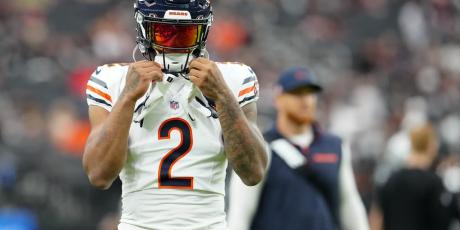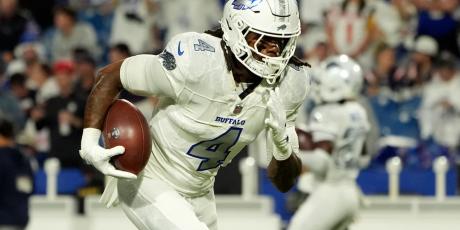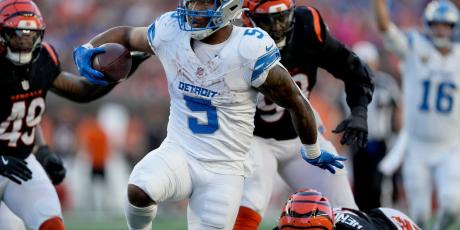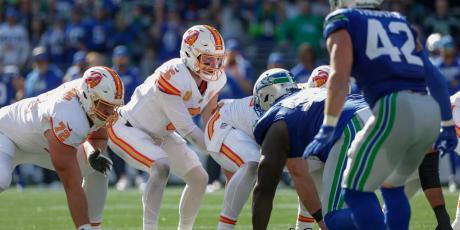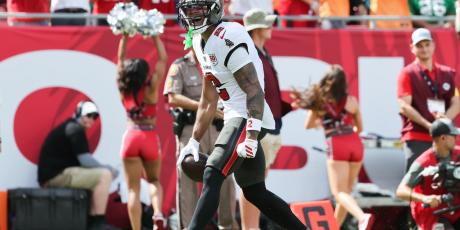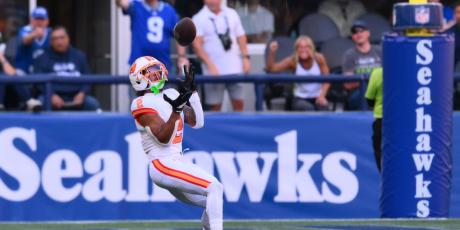An Introduction to NFL DFS
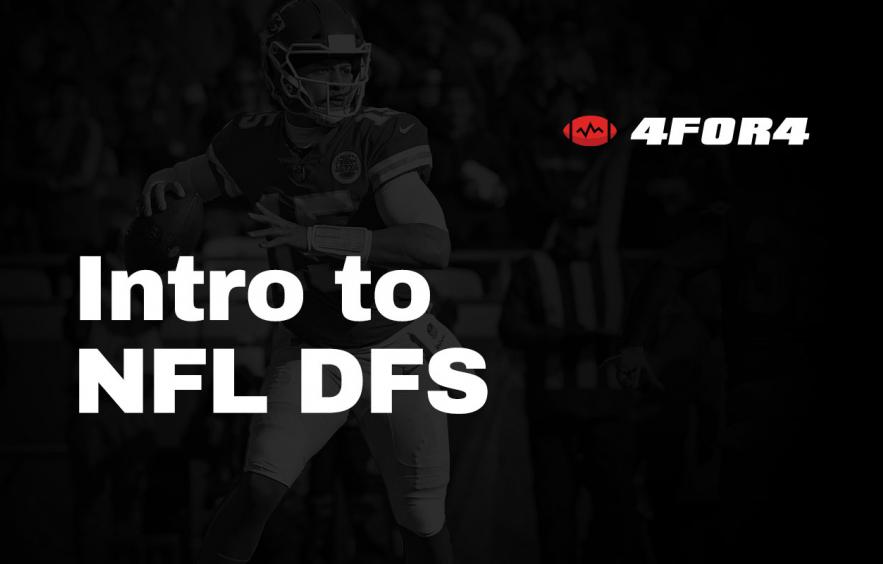
While DFS has soared in popularity in recent years, the number of players participating in daily games is still a fraction of those involved in traditional redraft leagues. For anyone considering trying out DFS for the first time, this guide will help get you started.
How to Play DFS
In a standard DFS contest, every player is assigned a salary and you're given a salary cap to fill out your roster. Lineup requirements and scoring vary by site but most platforms follow a relatively standard fantasy football structure. Contest types range from games against one other opponent to tournaments with thousands of players, and everything in between.
Which Games Should You Play?
It's crucial to understand your odds of winning. The goal is to minimize risk while building upside into the games you play. This is usually accomplished by putting the majority of your action in cash games and a small percentage in tournaments, or GPPs (Guaranteed Prize Pools).
What Type of Cash Games Should You Enter?
Different cash games have different odds of winning.
- Head to Heads: Play against one other player. Winner takes all (minus the rake or management fee).
- 50/50s: Finish in the top half of the field and split the money evenly with the rest of the players who finished in the top half.
- Double Ups: Slightly less than half of the field wins, but all winners double their money.
The safest strategy for cash games is to enter head-to-heads against a diversified sample of opponents. If you only play one opponent and that opponent has a great week, you could conceivably lose all of your money in play. However, if you play a diverse group of opponents, you will ensure that if you have a good score, your winning percentage will reflect that. This, of course, assumes that you can afford to play a diverse group of opponents—being able to play roughly 30 opponents at a single buy-in level is where you will usually start to see results that reflect the actual strength of your lineup.
Playing 50/50s and double ups can be riskier than head-to-heads. If your lineup has a 49th-percentile score, you could lose all of your entry fees if you played only 50/50s, whereas you would have still won roughly 49% of your games if you had played all head-to-heads against a diversified sample of opponents. For those who can only afford to play a couple games a week, though, 50/50s are preferable to head-to-heads—because of the payout structure, double ups are the riskiest cash game options, despite the fact that winners make slightly more than in head-to-heads and double ups.
For more on understanding rake, read this classic article.
How Many Lineups Should You Use in Cash Games?
If you are playing 30+ head-to-head contests against a diversified sample of opponents at one buy-in level, using only one lineup is the preferred strategy—as mentioned earlier, diversifying risk will be taken care of by the variety of opponents you are playing. Those who can afford a handful of 50/50s but can't afford to play enough head to heads to diversify through opponents should consider playing slight variations of their lineup in each 50/50, as to not lose all of their cash game investment in a single week.
For more on building cash game lineups, listen to this DFS MVP episode.
Which Tournaments Should You Enter?
The options for tournaments or GPPs are endless, making it impossible to offer a comprehensive list of games or specific strategies for every player and contest size. What every new DFS player should know is that the biggest contests and prize pools usually offer the worst odds and charge the highest rake. When searching for the most profitable games, players should consider the following:
- What percentage of players win money?
- How high is the rake or management fee?
- What percentage of money is going to first and how is the rest of the money spread amongst the winners? Similarly, how much do you make if you are the last player to win money?
The goal is to find the "flattest" payout structures, or the least top-heavy games. Your best bet is usually to leave the "Featured" games in the lobby and find less popular—but more profitable—contests. The tradeoff is the massive upside of featured games but chasing those huge payouts is a glorified lottery for most players.
Note: For both cash games and GPPs, many sites offer beginner-only contests. These games usually offer the best odds, lowest rake, and flattest payouts while excluding more experienced players that might have a huge advantage. Everyone, regardless of skill level, should play these games as much as possible for as long as they qualify.
For more on finding the most profitable games, listen to this DFS MVP episode.
How Many Lineups Should You Use in Tournaments?
In tournaments, both lineup and player diversification is key, for two reasons:
- Your lineup needs to be differentiated from what is usually a large field of opponents in order to place highly in or win a tournament.
- Tournaments dictate the selection of volatile players, who by nature are less predictable, which means you need to account for a greater range of outcomes.
When you play tournaments, it's recommended to multi-enter them with different lineups if that's an option (there are some tournaments that are single-entry only, which requires a slightly less risk-seeking approach). You want to create lineups in such a way that they don't contain many (if any) of the same players. This way, you give yourself multiple shots to finish near the top while at the same time not allowing one bad play in all your lineups to sink you. As your bankroll grows, you can play more lineups with a similar core with greater diversification around it.
For more on building tournament lineups, listen to this DFS MVP episode.
You Have $100. How Much Money Should You Play?
On a given day, it is not advisable to play more than 20% of your bankroll. New players should strongly consider starting with 10% of their bankroll. For a rough guide, always remember the 80/20/10 rule: 80% of your money in play in cash games, 20% in tournaments or GPPs, and no more than 10% of your total bankroll in any given week. This is an extremely conservative rule and assumes a lean towards cash games—for some, a GPP-heavy strategy might be best.
The important part of how much money you decide to put in play is to be consistent. If you're not consistent with your percentage of money in play, you run the risk of being a winning player yet not being profitable.
For example, assume you have a $100 bankroll and play 20% ($20), all in double-ups, and win them all. Now your bankroll is up to $120, and with extra confidence, you decide to play 50% ($60) of your bankroll the next week, but you lose all of your games. Now you're left with only $60, so the following week you get scared and go back to playing only 20% ($12) of your bankroll, but alas, you double up again, winning $24 to bring your bankroll to $72 after three weeks.
It's easy to see something's wrong there: you won big two out of three nights, yet your bankroll is smaller than before. If you had stayed consistent and played 20% each week, you would have made a nice profit. You would have only lost $24 the second week if you played 20% of your $120, ending with $96 rather than $60. Your money in play in Week 3 would have been $19.20 (20% of $96), and you would have ended up with $115.20. Despite having the same game results, just by being consistent with your money in play, you would have made a 15%t gain on your bankroll instead of losing 28%.
When deciding on money in play, you also have to take into account how strong of a player you are. Most DFS sites allow you to download your results, so over time, you'll get an idea of your baseline winning percentage in different types of games. The better player you are, the more money in play is acceptable.
For more on optimizing your wagers, check out this classic article.
What Should Your Buy-in Level Be?
Generally, the lower the buy-in level, the easier the competition. The best way to use this to your advantage is to always enter the lowest buy-in levels you can with your money in play.
So if you're playing $50 worth of head-to-heads, your best chances of winning would be by entering 50 contests at $1 each, rather than five contests at $10 each, for example.
Do this within reason, however—if you're not going to be able to manage 50 unique $1 tournament lineups, it's better to enter 25 at $2 each or 10 at $5 each instead. It makes the most sense to enter at the lowest buy-in level in head-to-heads and other cash games, because you won't be using many unique lineups.
Start studying to become the best DFS player possible by exploring all of the articles and podcasts in the 4for4 DFS Strategy Hub.

